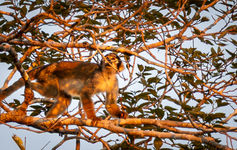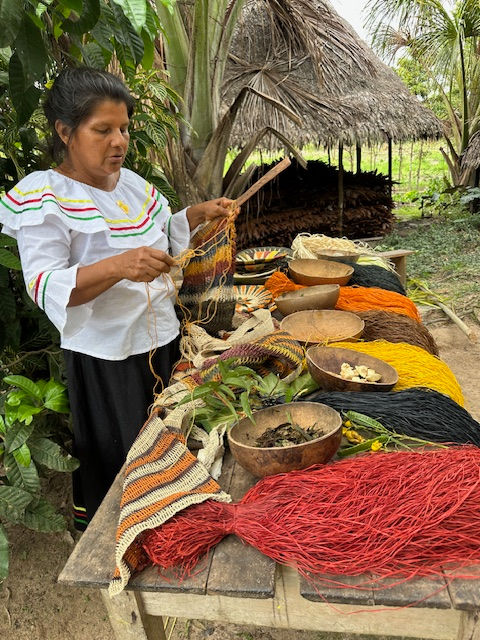


Amazing Amazon
Our Amazon adventure began in Lima, Peru, where we boarded a plane for a two-hour flight to Iquitos, a city located in the Peruvian Amazon jungle. From Iquitos, we took a 2 hour bus ride up river to Nauta to meet our ship. Multiple skiffs transported guests and luggage to the Delphin II, anchored in the river. Our first wildlife encounter was a snake—a red mamba hanging out in a tree on the path to the skiff dock.
Over the course of the week, we traveled primarily along the Ucayali and Marañón rivers, covering roughly 260 miles. The Ucayali and Marañón converge to form the Amazon River, which ultimately drains much of northern South America and touches nine countries. The Amazon basin spans about 40% of South America, with over 1,100 tributaries, making it the largest freshwater system in the world.
For comparison, the Amazon basin is roughly ¾ the area of the continental US. The Amazon’s fresh water extends roughly 200 miles into the Atlantic Ocean, creating a unique ecological zone. The river is in places as deep as 300 feet, and water levels fluctuate 30–40 feet annually due to melting snow and glaciers in the Andes coupled with seasonal rainfall. We were there in the low water season, which affects which creeks and waterways are navigable and creates different habitats for wildlife throughout the year.
Our ship had 14 cabins, each with wall-to-wall windows, so the views of the river were spectacular. Rooms were well appointed, and we had a different surprise towel sculpture every day. Iquitos, with a population of 500,000, can only be reached by air or water, making it the largest city in the world inaccessible by road. Where we began, the river was probably half a mile wide, but in some locations, it can be up to 20 miles wide.



Typically, on any given day there were two skiff explorations in the many creeks off the river—one after breakfast and another late afternoon. Each lasted about two hours, and we looked for whatever wildlife we could find. Each skiff had at least one naturalist and a driver, both very experienced spotters. Morning explorations found us flushing white egrets as we approached, and the sight of thousands of birds in flight was amazing. We spotted multiple species of herons and kingfishers, scarlet macaws, harpy eagles, parrots, hoatzins, toucans, and too many others to mention. Afternoon skiff explorations were similar, though by then the white egrets were already awake!
Photography opportunities were incredible, from early morning and late afternoon light to after-dark excursions when the river came alive with sounds and colors. Birds were the standout. We saw 123 species of birds, four species of monkeys, two species of dolphins, three-toed sloths, caiman, and even a red mamba.
The region’s agriculture is hidden throughout the jungle, ranging from family farms to large-scale agro-industry. Family farms may be for sustenance or cash crops. Fruits and vegetables include local varieties such as aguaje, camu camu (small red berries high in vitamin C for juice), açaí, pineapples, passion fruit, bananas, cassava, maize, and rice. Commercial cash crops include cacao, coffee, oil palms, and timber. Other important plants include herbs and medicinal plants cultivated and sold, often by shamans. Fishing and fish farming are also important to locals, and we enjoyed fresh paiche, catfish, and tambaqui prepared on the ship.
Speaking of food, the chef created some amazing meals. Breakfast was buffet style, but lunch and dinner were presentations—beautiful and delicious, each with an appetizer, main course, and dessert. The ship even had its own pastry chef! The ceviche was particularly delicious, and one afternoon the chef gave a demonstration on making it, complete with a recipe. Other presentations included local fruits of the Amazon and how to make the perfect pisco sour. Our photography expert gave a talk on hidden features of the iPhone camera and composition.


One afternoon, we had the opportunity to swim in one of the deeper creeks. We floated over the side of the skiff onto noodles. Swimming was an overstatement as we paddled around. No piranhas were in sight. That’s not to say we didn’t have the occasional nip from local fishes. The nips were sometimes a bit uncomfortable, definitely caught you off guard, but nothing drew blood. Even Betsey was able to get into the water, just eight weeks post-surgery—thank you, Dr. Allen! The water was a very comfortable temperature.
As the ship cruised from one location to another, we would also see two different kinds of dolphins—grey and Amazon river dolphins, known as pink dolphins. Grey dolphins are smaller than pink ones. Pink dolphins start out grey, but the males turn pink as they age. Often, they were in groups. Late afternoon we went out on the skiffs for another round of exploration in a new part of the river. A few times, we went out after dark to observe the nightlife. We found plenty of caimans, a close relative of the alligator. The smaller ones were kind of cute, but the eight-foot ones were imposing when viewed from a skiff at night. The river currents were strong, though the creeks, big and small, had less current, making them easier to explore.
Towards the end of our journey, we found ourselves near where the Ucayali and Marañón merge into the Amazon. Our sunset excursion had all three skiffs rafted together at the confluence, where we toasted the river and the trip with some bubbly—a truly memorable moment.
Our final stop was at a local village supported by Lindblad. We visited woodworking areas where canoes were under construction, peeked into the school, and saw village homes. The small market offered baskets, bags, and other handcrafted goods—a reminder of how communities along the river blend tradition with daily life. What stood out most was the warmth of the people, who welcomed us with easy smiles and genuine curiosity.
Life in the village was simple but deeply connected to the river and the forest. The canoes under construction showed the community’s reliance on river transport, while the school emphasized the importance they placed on education for the next generation. The market stalls, with beautifully woven baskets and brightly colored bags, were a glimpse of both cultural pride and economic resourcefulness. It was a privilege to see how these communities thrive in such a remote environment, sustained by the same river we had been exploring all week.
This journey left us with not only unforgettable memories of wildlife and river life, but also a deep appreciation for the people and the environment that make the Amazon such a remarkable place. Along the way, we also made new friends—fellow travelers who shared our excitement each time a sloth was spotted or a dolphin surfaced. The mix of discovery, laughter, and shared toasts at sunset made the week even more special. For us, the Amazon was truly a bucket-list trip, one that will stay with us long after the last photo is sorted and the stories are retold around the table at home.


































































